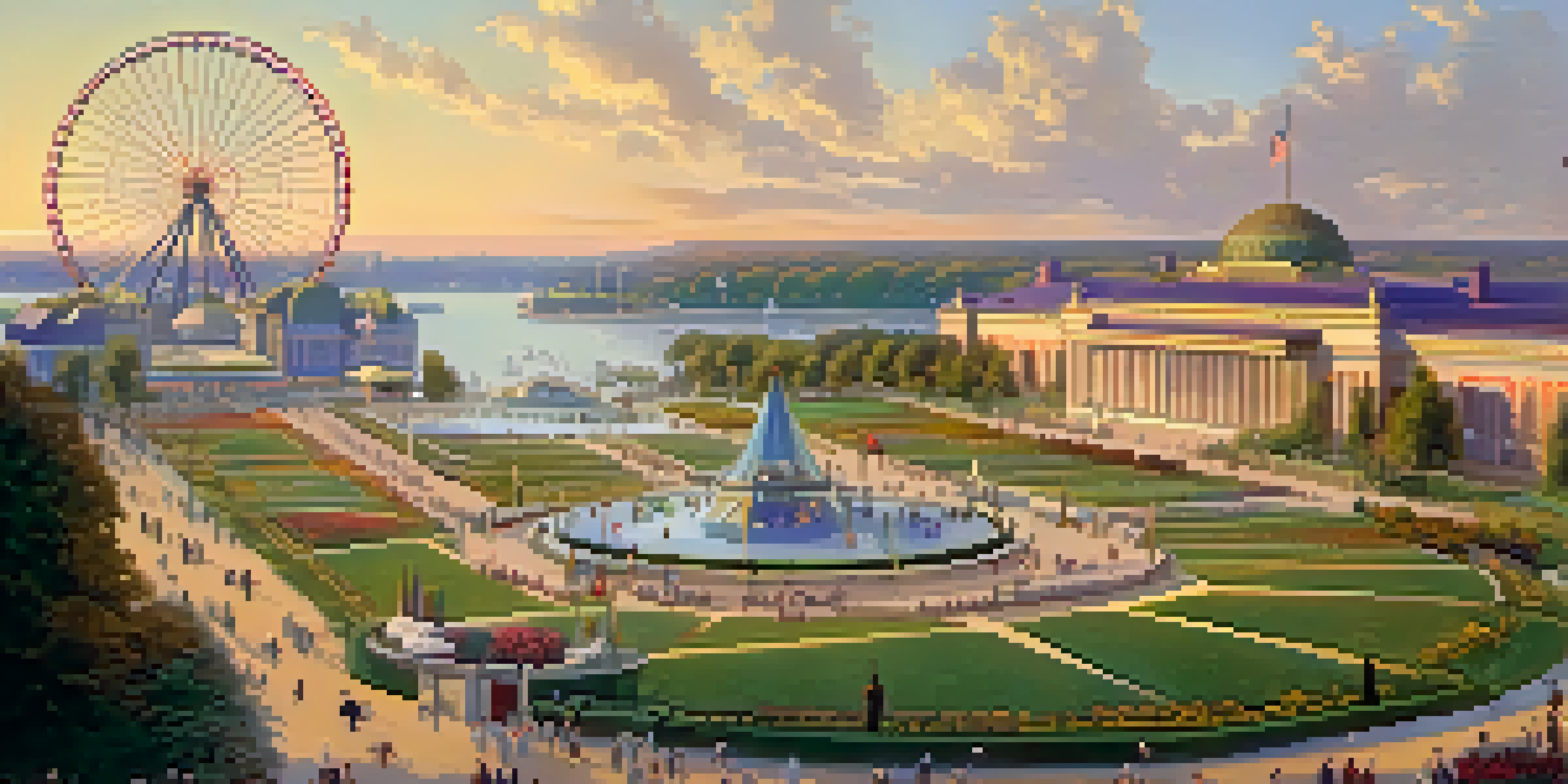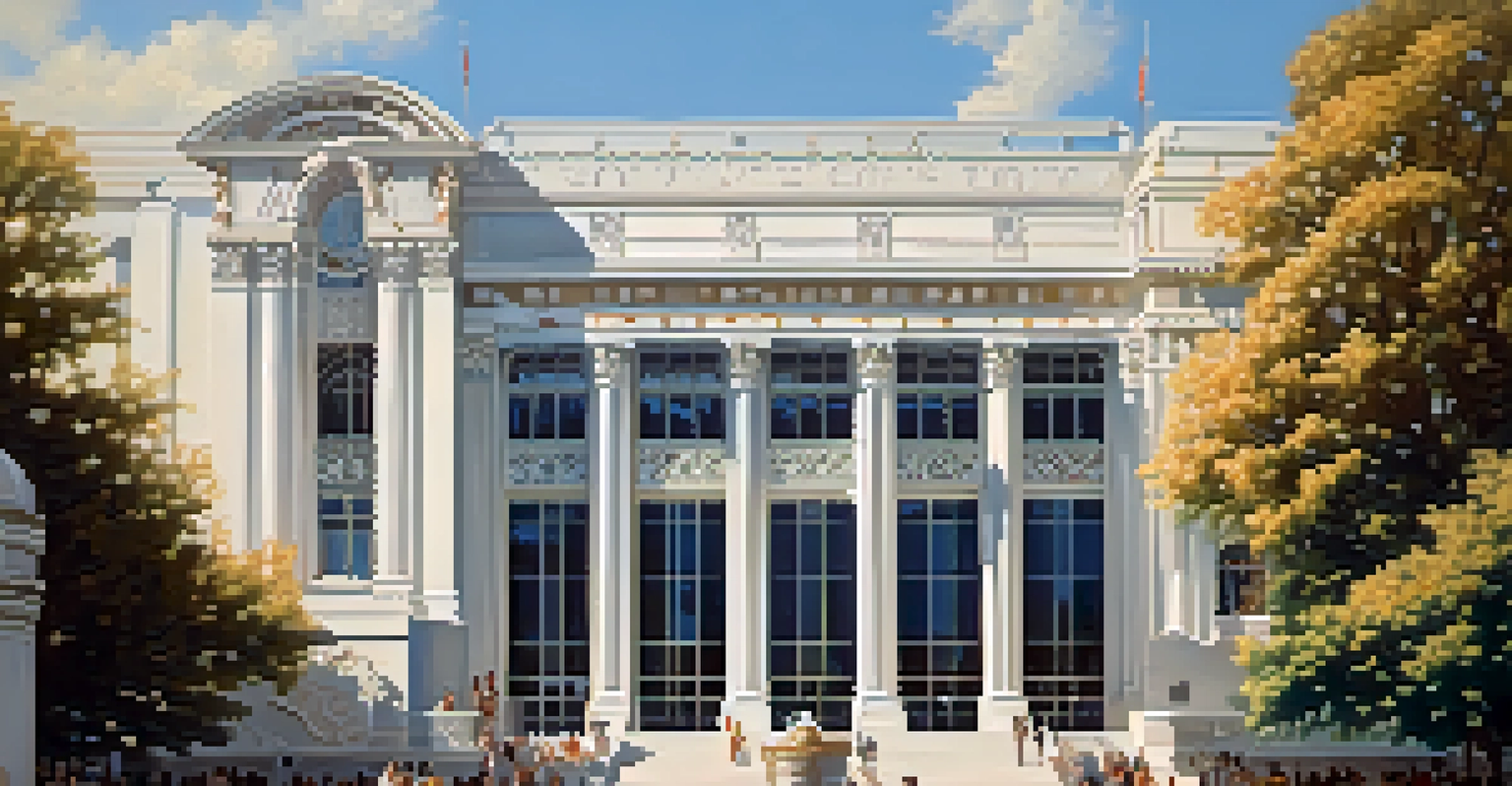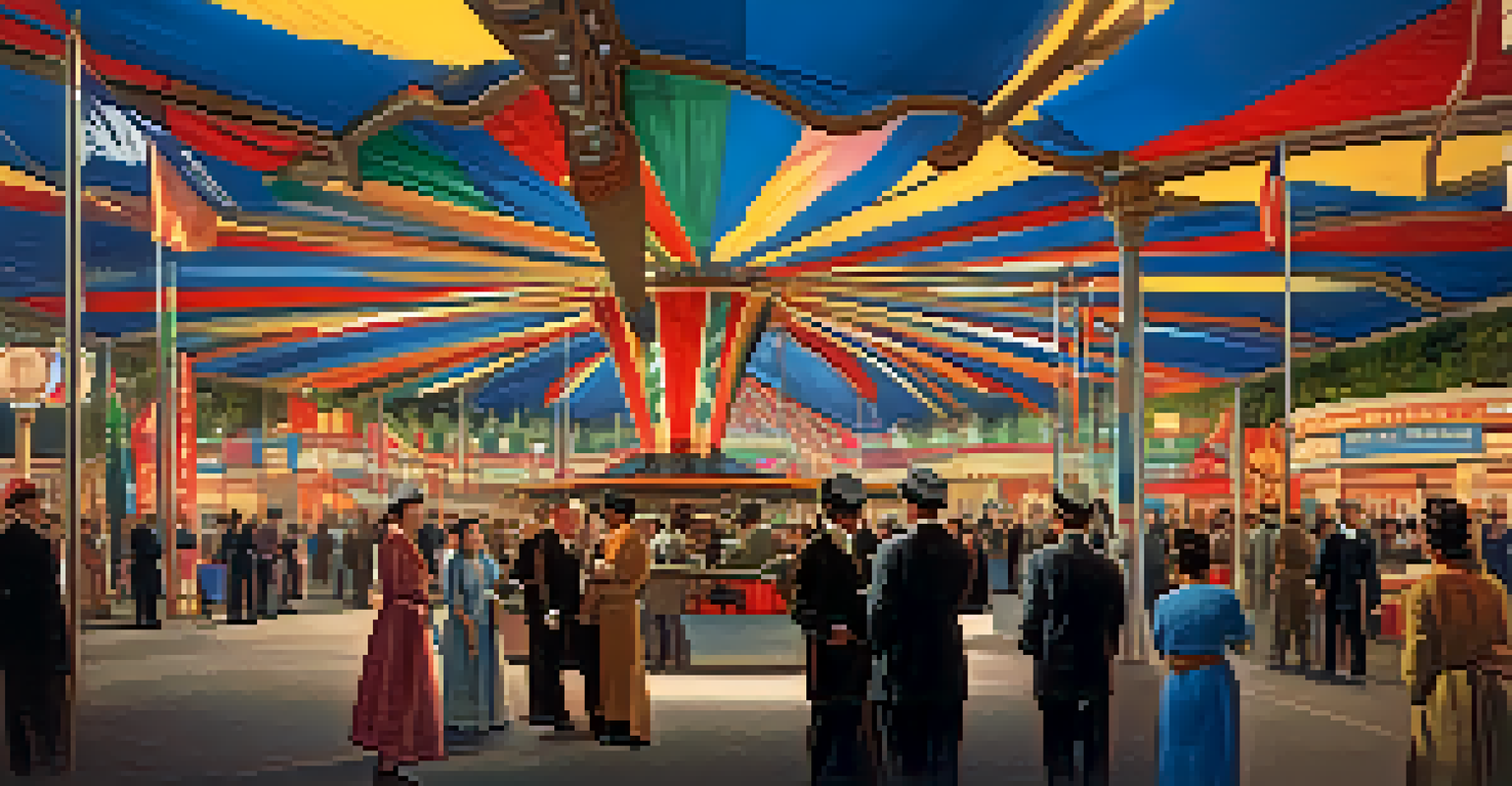The Chicago World's Fair of 1893: A Cultural Landmark

An Overview of the 1893 Chicago World's Fair
The Chicago World's Fair, officially known as the World's Columbian Exposition, was held in 1893 to celebrate the 400th anniversary of Christopher Columbus's arrival in the Americas. This monumental event attracted over 27 million visitors, showcasing innovations and cultural exhibits from around the globe. With its grand architecture and groundbreaking technologies, the fair became a pivotal moment in American history.
The fair not only entertained but also educated the public about progress and innovation.
The fairgrounds, located in Jackson Park, featured stunning neoclassical buildings, many of which were painted white, earning it the nickname 'The White City.' Designed by prominent architects, the buildings highlighted the City Beautiful movement, which aimed to inspire pride and improve urban environments. This architectural elegance contrasted sharply with the industrial backdrop of the time.
Visitors were treated to an array of attractions, from the first Ferris wheel to stunning displays of electricity and steam power. The fair not only entertained but also educated the public about progress and innovation. It set the stage for future expositions and left an indelible mark on American culture and society.
Cultural and Technological Innovations
The 1893 fair was a hotbed for technological advancements, showcasing inventions that would revolutionize everyday life. One of the most notable was the introduction of the Ferris wheel, which stood 264 feet tall and became an instant sensation. This engineering marvel not only provided breathtaking views of the fairgrounds but also symbolized the spirit of innovation that defined the era.

Electricity played a pivotal role at the fair, with the dazzling display of Edison’s electric lights illuminating the buildings and walkways. This dramatic use of electricity captivated visitors and demonstrated its potential for transforming modern living. The fair effectively marked the beginning of a new age, where electrical power began to infiltrate homes and cities across America.
Celebrating Innovation and Culture
The 1893 Chicago World's Fair showcased groundbreaking technologies, cultural diversity, and artistic achievements, leaving a lasting impact on American society.
Beyond technology, the fair also embraced cultural diversity, featuring exhibits from various countries. These displays allowed visitors to experience different cultures and traditions firsthand, promoting a sense of global interconnectedness. This cultural exchange fostered a greater appreciation for diversity, which continues to resonate in today's multicultural society.
Art and Architecture at the Fair
The artistic vision behind the Chicago World's Fair was nothing short of extraordinary. Renowned architects, including Daniel Burnham and Frederick Law Olmsted, designed the fairgrounds with an emphasis on beauty and harmony. The use of classical styles and meticulous landscaping created a serene environment that drew visitors in and left them in awe.
This celebration of the arts not only enriched the visitor experience but also paved the way for future artistic movements in America.
Art was also a central theme, with the fair featuring an extensive collection of paintings, sculptures, and decorative arts. The World’s Fair showcased the works of prominent artists and provided a platform for emerging talent. This celebration of the arts not only enriched the visitor experience but also paved the way for future artistic movements in America.
Additionally, the fair served as a catalyst for the City Beautiful movement, influencing urban planning and architecture in cities across the United States. The emphasis on aesthetics and public spaces inspired future generations of architects and city planners to create more livable and beautiful environments. The legacy of this movement is still evident in many American cities today.
The Role of Women at the Fair
Women played a significant role in the success of the 1893 Chicago World's Fair, both as organizers and participants. The Women's Building, designed by architect Sophia Hayden, was a landmark achievement, showcasing women's contributions to society. This space highlighted the importance of women's education and empowerment, offering a platform for their voices.
Women exhibited their achievements in various fields, from art to science, challenging traditional gender roles of the time. The fair provided an opportunity for women to demonstrate their capabilities, fostering a sense of pride and accomplishment. This shift in perception laid the groundwork for future advancements in women's rights.
Role of Women in Progress
Women played a crucial role at the fair, challenging traditional gender roles and advocating for education and rights, marking a significant moment in the fight for gender equality.
The fair also hosted several influential figures, including suffragists who advocated for women's voting rights. Their presence underscored the growing movement for gender equality, making the fair a historical moment in the fight for women's rights. The impact of these efforts would resonate long after the fair concluded, shaping the future for women in America.
The Fair's Enduring Legacy
The Chicago World's Fair of 1893 left a profound legacy that extends far beyond its closing day. It inspired future world’s fairs and expositions, setting a standard for showcasing innovation and culture on a global stage. The fair demonstrated the power of collaboration among nations and cultures, fostering a spirit of unity and mutual respect.
The architectural and urban planning principles established during the fair have influenced city design in countless ways. Many cities adopted the City Beautiful ideals, focusing on aesthetics and public spaces to improve urban life. This legacy continues to be relevant today as cities strive to balance functionality with beauty.
Moreover, the fair's cultural impact can still be felt in modern society, as it encouraged a dialogue about diversity and inclusion. By showcasing the contributions of various cultures, it paved the way for a more global perspective. The lessons learned from this monumental event remain vital as we navigate the complexities of a rapidly changing world.
Controversies Surrounding the Fair
While the Chicago World's Fair was a grand celebration, it was not without its controversies. The fair's planning and execution were fraught with political and economic tensions, reflecting the tumultuous climate of late 19th-century America. Disputes arose over funding, labor conditions, and the representation of various groups.
One major controversy involved the treatment of the indigenous peoples displayed at the fair. Many Native Americans were brought in to represent their cultures but were often portrayed in a stereotypical manner. This practice raised ethical questions about representation and exploitation, prompting discussions that are still relevant today.
Controversies and Exclusions
Despite its grand celebration, the fair faced controversies regarding the representation of indigenous peoples and the exclusion of African Americans, highlighting ongoing struggles for equality.
Additionally, the fair's legacy is complicated by the exclusion of certain groups, particularly African Americans. While there were attempts to include their contributions, many were sidelined or overlooked entirely. This exclusion highlights the ongoing struggle for representation and equality, reminding us of the work still needed to recognize diverse voices in history.
Visiting the Site Today
Today, the site of the Chicago World's Fair is a historical landmark that attracts visitors interested in its rich history. Jackson Park, where the fair was held, has been preserved and features several monuments and attractions that commemorate the event. The park remains a vibrant space for recreation and community gatherings, echoing the fair's original spirit.
Visitors can explore the area, which includes the scenic Japanese Garden and the Museum of Science and Industry, housed in one of the fair's original buildings. This museum continues the legacy of innovation, offering interactive exhibits that engage and educate. It's a fitting tribute to the pioneering spirit that defined the fair.

Moreover, the fair's influence is celebrated through various events and educational programs held in the park. These initiatives aim to keep the history of the fair alive while fostering discussions about its impact on society. For those curious about America's past, a visit to this historic site offers a unique glimpse into a transformative era.